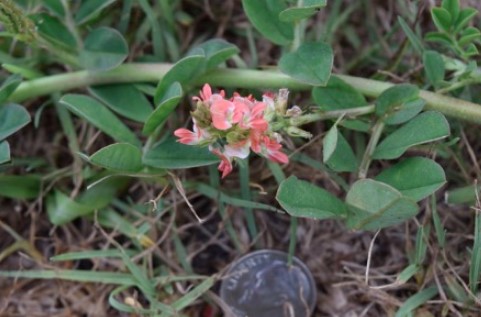By Les Harrison
The calendar and thermometer indicate the return of consistent warm weather is arriving soon. With it come forage production for grazing and hay, and the many weeds which create an assortment of problems. Included is Creeping indigo, Indigofera spicata, a weed with many traits equivalent to a malicious stalker whose sole purpose is to conquer territory and sow problems. This commonly overlooked exotic invader does not get the attention of the long list of infamous invasive plants such as kudzu, cogongrass, and climbing fern.
A native of Africa and southern Asia, creeping indigo is a legume. Most legumes are viewed favorably by the agricultural community, since they possess nitrogen-fixing bacteria in their root nodules. Creeping indigo was introduced to Florida from Ceylon (Sri Lanka) around 1925 as part of a research project to investigate several properties including nitrogen fixation and it’s potential as a forage crop for the livestock industry. While this species was considered to have a good nitrogen fixing capacity, there were other features which were not appreciated. Livestock toxicity issues began to be a concern of researchers as early as 1933.
Historically, most of the Indigofera species were used for production of indigo dye, which resulted in deep blue shades in a variety of textiles. Over time this stable dye became a valuable commodity, and was hauled by way of pack animals to distant locations for barter in ancient markets and bazaars. Creeping indigo does not contain as much dye as other species in its genus, and was ignored as a valueless weed until the early 20th Century. While legumes such as clovers and perennial peanut make excellent forage, there is an ongoing search for the next improved option.
When early test as potential forage were conducted on rabbits, one did not survive the initial grazing trial. The surviving rabbit recovered after creeping indigo was removed from the diet. Besides rabbits, equine, cattle, sheep, goats, guinea pigs, and birds have also been poisoned by this exotic plant. Swine, demonstrating exceptionally good sense, will not eat this plant and have avoided it in feeding tests.
Identification of creeping indigo in late autumn is aided by the very distinctive seed pod clusters. Seed pods are straight and approximately an inch long in densely packed groups of about one hundred pods per stalk. These downward-pointing clusters are bright green when immature, but dry to a matte black during the winter. The pods easily shatter when bumped or struck by an animal and will scatter the tiny seeds within.
Creeping indigo seed pods form in clusters and are typically stiff, pointed, and facing downward.
During the growing season, creeping indigo is a lowing growing plant which lies over in a prostrate fashion potentially reaching six feet in length. Leaves contain seven to nine hairy leaflets and stems are hairy, too. Flowers appear at the base of the leaves, and contain numerous pink blooms during the summer. Soon after the pretty flowers disappear, this creeping beauty becomes a forage producer’s nightmare.
Hairy Indigo Indigofera hirsuta is a non-toxic relative of creeping indigo. Hairy indigo generally has a much more erect growth habit than its creeping cousin. However, when the plants are very young or when hairy indigo is regrowing after being mowed the two species look rather similar. One way to tell the species apart is to look at the arrangement of the leaflets. Creeping indigo leaflets have an alternate attachment on the petiole while hairy indigo leaflets are opposite. For help distinguishing the two species contact your county’s
UF/IFAS Extension Office.

Flowers of creeping indigo arise from the base of the leaves and are pink to salmon in color.